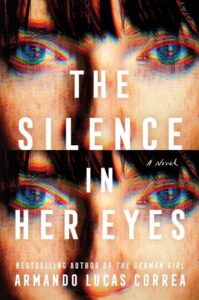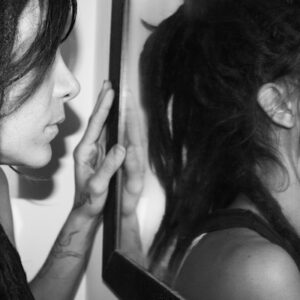The Silence in Her Eyes is a book I wasn’t supposed to write.
The first time I told my editor that I was thinking about writing a psychological thriller, she was taken aback. She responded with a groan: “Why do all my authors suddenly want to write thrillers?” If my historical novel The German Girl sold more than a million copies, she said, why would I suddenly want to switch genres? A fair question. But even though it came out of the blue to her, it was actually something I’d been thinking about for years.
The very day I finished writing The German Girl, I began fleshing out a new story. I was fully aware that I needed to write the two historical novels I already had under contract: The Daughter’s Tale and The Night Traveler. However, I decided to take some time to work on a different concept that I couldn’t get out of my head.
Here was the original idea: In an apartment that closely resembles my own (I’ve noticed all my novels partly take place where I live), a professor from Columbia University is found unconscious and lying in a pool of blood at his doorstep. The surrounding blood is his own, his wife’s, and their three-year-old daughter Leah’s. Neither his wife’s body nor his daughter’s is found. The building’s security cameras had been turned off. Nothing had been stolen from the apartment. Were they murdered or kidnapped? Twenty-five years later, the professor, who has become a bestselling author by recounting the story of his family’s disappearance and how he coped with the loss, receives a visitor. When he opens the door, he is met with a young woman holding the key to his front door in her hand. In that instant, he recognizes his daughter, Leah, and senses the silence in her eyes. Working from the premise that nothing is as it seems, I began to outline this story.
As you will discover, The Silence in Her Eyes ultimately turned out to be a very different book than the one I’d first conceived. Maybe after I finish the next two novels I owe my publisher — yes, they acquired the rights to the thriller on the condition I also write two more historical novels— I’ll return to the original plot of Silence and find out what happened to that girl during the twenty-five years she went missing.
The challenge for me was that, while secretly writing The Silence in Her Eyes, I was also working on other novels. I think that happens to a lot of writers: our minds work faster than our hands. I was scouring medical textbooks for a reversible medical condition – preferably some form of blindness – for one of the characters in What We Once Were, my next work of historical fiction. As you probably know, there are various types of blindness. One is called prosopagnosia (not a catchy name), also known as face blindness or facial agnosia, which is the inability to recognize faces. (Doesn’t that happen to all of us at times?) However, that form of blindness didn’t fit my story. That’s when I discovered another form of blindness called akinetopsia, the inability for someone to perceive moving objects. The word akinetopsia comes from the Greek: “a” for without, “kine” for movement, and “opsia” for seeing. This rare but true condition – a brain structure alteration due to an injury that can be reversible – immediately struck me as a fascinating element to be used in a suspense novel.
With that discovery, my under-the-table thriller took an unexpected turn in the blink of an eye. The protagonist would still be a young woman named Leah. The plot would still unfold in the Morningside Heights neighborhood where I live. In the same apartment with French doors overlooking one of the most beautiful, creepy, and dangerous parks in Manhattan: Morningside Park. I still don’t allow my children to walk through that park when they are traveling to or from school. The apartment would be in a classic pre-war Manhattan building, with a dark and terrifying basement. I recall working on the first draft alone in my apartment while my children were at our Upstate house and getting chills. I’m still convinced I heard strange noises coming from behind the walls.
With The Silence in Her Eyes, I constructed a story from the perspective of a 28-year-old woman who had an accident at age seven that rendered her unable to see movement. For the first time in her life, she is alone. She has just buried her mother, and her only connections to the outside world are the woman who has cared for her since she was a child, two elderly women who live in an apartment upstairs, her psychiatrist, and two social workers who occasionally visit her. She lives in a world seemingly populated by salt statues that vanish in a blink. A place where books come to life when she reads them. And through sounds and scents, she can perceive what her eyes fail to capture—and more.
The basic story gradually became clear in my mind. The challenge was the style. Initially, the book was narrated in the third person. When I finished, I realized that perspective didn’t work. It needed to be told in the first person. As a reader, you needed to inhabit Leah’s mind: think, smell, hear, and experience the world like her. The chapters had to be short, sometimes even fragmented. Each chapter had to reflect Leah’s static, stroboscopic perspective on her surroundings. I wanted readers to have that experience.
I delved into brain studies. I accompanied my eldest daughter to a laboratory in New Jersey to examine and dissect a human brain – she was finishing high school and wanted to do pre-med in college. I asked the doctor a litany of questions, held the brain in my hands, and was captivated. My daughter, on the other hand, ended up enrolling in Mechanical Engineering.
I must confess, although I read a lot – I think of myself as a reader who writes – I’m not an avid reader of thrillers. While writing The Silence in Her Eyes, the authors accompanying me were Garth Greenwell, Maggie O’Farrell, Hanya Yanagihara, Ocean Vuong, Hernán Díaz, W.G. Sebald, Thomas Bernhard, José Lezama Lima, Lauren Groff, Benjamin Labatut, and Emmanuel Carrère, some of my favorites. However I did revisit great thriller movies like Rosemary’s Baby and Vertigo, as well as the books they were based on.
A review in Publishers Weekly said that this book “bring[s] new life to the familiar Rear Window (Alfred Hitchcock) conceit, wrapping things up with a stunning finale that forces readers to reevaluate each character and their motives.” I was flattered by the praise, but if there’s one Hitchcock movie that inspired me while writing my novel, it’s Vertigo. I was a teenager the first time I saw it, and for me, it is the genius director’s masterpiece. I sought out Vertigo in the neighborhood cinemas of my native city, Havana, and as soon as I saw it, I knew I wanted to be a writer. (Well, that’s not quite true. As a child, every time I finished a book, I dreamed about becoming a writer.) In his book Twentieth Century Job, the Cuban writer Guillermo Cabrera Infante, who began his career as a film critic, wrote about the movie in a way that left a mark on me. He said that Vertigo takes place “among the dead, in search of lost love,” and described it as a surreal film about a necrophilic story.
Vertigo gave me the idea of creating two books in one. In chapter thirty — the book has fifty-one chapters — the plot reaches a climax when Leah makes a decision that will forever change her life and the universe she has built around her. From that moment on, it’s as if a new story begins. Nothing is as it seems. The boundary between good and evil is obscured. I’m reminded of Aleksandr Solzhenitsyn, a Russian writer and Soviet dissident who, for those of us who grew up under a dictatorship, was something of a God. Solzhenitsyn wrote: “And even within hearts overwhelmed by evil, one small bridgehead of good is retained. And even in the best of all hearts, there remains … an un-uprooted small corner of evil.”
In my historical novel The Daughter’s Tale, there is in a chapter where one of the characters commits suicide in a bathtub — one of my favorite passages. My editor commented: “Armando, there are too many deaths, too much blood. This is not a thriller!” I adjusted the scene a bit, but the death remained. It seems that I already had a thriller writer lurking inside me, without even knowing it.
As you can see, what I really enjoy on a creative level is telling stories. Assigning a specific literary genre comes after. In every book I write, I’m always very conscious of style and rhythm. The plot must develop at a consistent pace. I conceive scenes sometimes as if they were theatrical or cinematic.
Often, we writers are heavily influenced by the (always well intentioned) advice of agents, editors, publicists, and of course, booksellers. They seek to offer you, the readers, the best possible book, and in that I fully agree. But sometimes, it’s necessary to listen to your heart and write the story that won’t let you go, the one you can’t stop thinking about even though your head says you probably should.
Now I only hope that my agent and editor don’t want me to write thrillers exclusively. I have a lot more stories I want to tell.
***


















